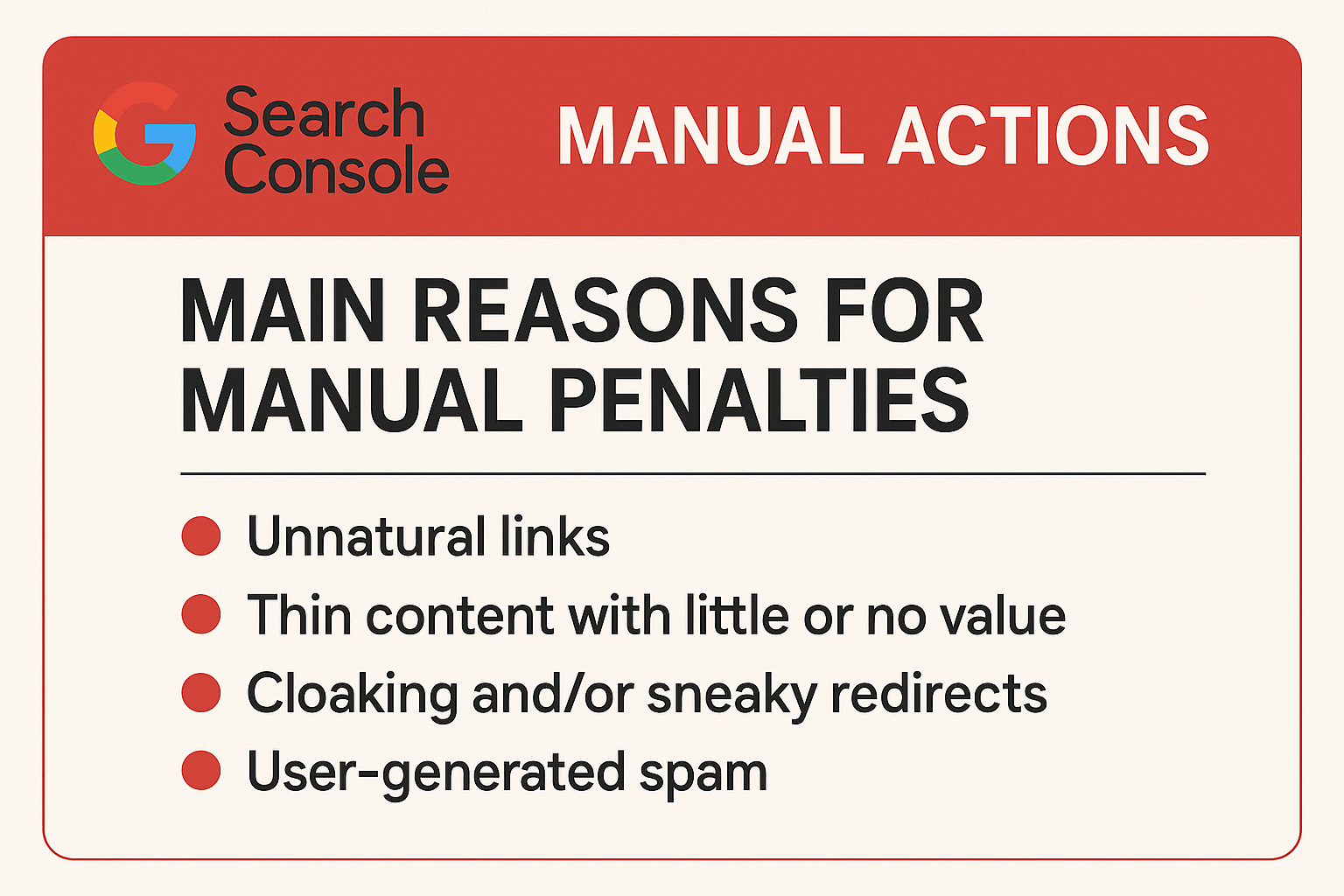Google Search Console (GSC) manual actions can be a (How to Avoid Penalization) nightmare for website owners. If Google’s human reviewers penalize your site, your rankings may plummet, and your traffic could vanish overnight. But don’t panic—understanding the main reasons for manual penalties and knowing how to avoid them can save your site from disaster.
In this guide, we’ll break down the most common causes of GSC manual actions, provide real-world examples, and offer practical solutions to keep your website in Google’s good graces.
What Is a Google Search Console Manual Action?
A manual action (previously called a “manual penalty”) is when a human reviewer at Google determines that your site violates their Webmaster Guidelines. Unlike algorithmic penalties (like those from Panda or Penguin), manual actions are applied by real people after reviewing your site.
If you receive one, you’ll see a notification in your Google Search Console account under the “Manual Actions” report. The message will explain the issue and what you need to fix.
Main Reasons for GSC Manual Actions (And How to Avoid Them)
1. Thin or Low-Quality Content
Google prioritizes high-quality, valuable content. If your pages are stuffed with fluff, duplicate content, or auto-generated text, you risk a manual penalty.
Examples of Thin Content:
-
Pages with little or no original content.
-
Doorway pages (pages created only to rank for keywords).
-
Scraped or spun content from other sites.
How to Fix It:
-
Rewrite or expand thin pages with in-depth, useful information.
-
Remove duplicate content by using canonical tags or merging similar pages.
-
Avoid auto-generated content—always write for humans, not just search engines.
2. Unnatural Links (Spammy Backlinks or Link Schemes)
Google penalizes sites that engage in black-hat link-building, such as buying links or participating in shady link exchanges.
Examples of Unnatural Links:
-
Paid links without the
nofollowattribute. -
Links from PBNs (Private Blog Networks).
-
Excessive keyword-rich anchor text in unnatural ways.
How to Fix It:
-
Audit your backlinks using tools like Ahrefs or SEMrush.
-
Disavow toxic links through Google’s Disavow Tool.
-
Focus on earning natural links through great content and outreach.

3. User-Generated Spam (Comments, Forum Posts, etc.)
If your site allows user-generated content (UGC), like blog comments or forum posts, spammy links can sneak in and trigger a penalty.
How to Fix It:
-
Moderate all UGC before it goes live.
-
Use
nofollowon UGC links to prevent spammy backlinks. -
Disavow harmful links if spam slips through.
4. Cloaking or Sneaky Redirects
Cloaking (showing different content to users vs. Googlebot) and sneaky redirects (sending users to a different page than promised) are serious violations.
How to Fix It:
-
Ensure your site shows the same content to users and search engines.
-
Avoid deceptive redirects—only use them for legitimate purposes (e.g., mobile redirects).
5. Hidden Text or Keyword Stuffing
Old-school black-hat SEO tactics like hiding text (white text on a white background) or overloading pages with keywords can lead to penalties.
How to Fix It:
-
Remove hidden text and ensure all content is visible.
-
Use keywords naturally—avoid stuffing them unnaturally.
6. Hacked Content
If your site gets hacked and injects malware, spam, or phishing content, Google may manually penalize it.
How to Fix It:
-
Scan for malware using tools like Sucuri or Wordfence.
-
Remove hacked content and secure your site (strong passwords, updates, etc.).
-
Submit a reconsideration request once fixed.
How to Check for Manual Actions in Google Search Console
-
Log in to Google Search Console.
-
Go to Security & Manual Actions > Manual Actions.
-
If you see a warning, review the details and take action.

How to Recover from a Manual Penalty
-
Identify the issue (read the GSC notification carefully).
-
Fix all violations (remove spam, improve content, clean up links).
-
Submit a reconsideration request (explain what you fixed).
-
Wait for Google’s response (can take days or weeks).
Proactive Ways to Avoid GSC Manual Actions
✅ Publish high-quality, original content.
✅ Build links ethically—no PBNs or paid links.
✅ Monitor user-generated content for spam.
✅ Regularly audit your backlinks.
✅ Keep your site secure (prevent hacking).
Frequently Asked Questions (FAQs)
Q1: Can a manual penalty be reversed?
Yes! Once you fix the issue, submit a reconsideration request in GSC.
Q2: How long does it take to recover from a manual action?
It varies—some sites recover in a few days, others take weeks or months if the issue is severe.
Q3: Does a manual action affect the whole site or just specific pages?
It depends—Google may penalize individual pages or the entire site if violations are widespread.
Q4: Can algorithmic penalties turn into manual actions?
No—algorithmic penalties (like from Google updates) are automated, while manual actions are applied by humans.
Final Thoughts
Avoiding GSC manual actions comes down to playing by Google’s rules. Focus on quality content, ethical SEO, and regular site audits to stay penalty-free.
If you’ve been hit with a manual action, don’t panic—follow the steps above to recover and get back on track.
Disclaimer
This post is for educational purposes only. If you have any concerns about this content, please refer to our DMCA page for removal requests. Always verify ownership or issues related to this post before taking action.
